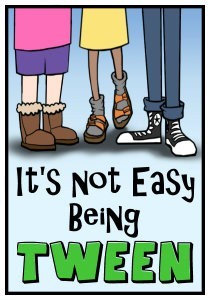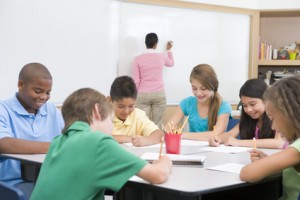Background Knowledge: 12 Ways to Set the Stage
A MiddleWeb Blog

However, because I know my students, I know full well that the reason they didn’t enjoy it is often that they didn’t understand the text’s vocabulary or have any connection to the book’s setting, characters, or subject matter.
It stands to reason that they would not enjoy the experience. Because we also read whole class novels, I don’t want students to have the same negative experience with the texts we share together. For this reason, I incorporate several strategies to help them connect to the text prior to opening the cover.

It is not a bad thing to engage in productive struggle to comprehend a text. The difficulty is when the struggle is not productive and is, instead, a source of frustration. This causes readers to abandon texts or to hate reading.
Frontloading background
Therefore I feel it is a disservice to students to neglect to frontload meaningful background prior to the reading of an entire novel. In a 2014 MiddleWeb article called Teach Kids to Build Their Own Prior Knowledge, literacy expert Linda Robb writes,
If we want to stretch students’ reading ability by developing their reading skill, then it’s important to set the stage for reading complex, unfamiliar texts by helping students build prior knowledge before reading, so close reading becomes a positive and engaging experience that’s within their reach.”
I agree and have reaped the benefits of doing so over the years, gauged by the feedback of students who say that they may not have chosen the text we read together, but that they loved it and want to read other, similar titles.
Activating prior knowledge and building background knowledge are crucial for many reasons. Among them:
- Even the most fluent of decoders don’t always connect with or comprehend what they read.
- Providing correct information can clear up any misconceptions.
- Practicing inference while reading is valuable, but an inference is only as good as one’s background knowledge allows.
- New knowledge is constructed from old. Learners make sense of content using their schema.
- Incorporating the best comprehension practices in the world cannot compensate for a lack of background knowledge.
- Having a framework upon which to build new learning makes reading more efficient, cements recall, and provides a means to organize the new information.
- Because my students come from diverse backgrounds, the only level playing field is my classroom, and building foundational knowledge gives everyone a fighting chance.
- Pre-reading strategies build curiosity, increase engagement, and allow the reader to more fully engage with the text.
- Allowing the opportunity to preview the material a bit encourages readers to set their own inquiry topics to explore.
Starting with prior knowledge
Activating prior knowledge is a good first step. In 1986 Donna Ogle invented the oft-used KWL strategy to help teachers ascertain the current level of knowledge students had on a topic and to encourage the learner to construct their own learning. It is still a valid strategy, but I use a couple of others as well.

As the teacher, prior to reading any text I need to decide what information is incidental and only needed for that particular unit and what is core and will be needed for future endeavors. This allows me to determine the vocabulary to be taught, set a purpose for reading a specific piece, and formulate essential questions that will be relevant and engaging to my students.
For example, essential questions I may ask before reading Roll of Thunder, Hear My Cry are “How does discrimination affect people?” and “How can someone stand up to discrimination?” This becomes the foundation for the “backward design” of the unit.
Ways to set the stage
There are myriad techniques for building background knowledge and establishing context for a text. This list is by no means exhaustive, nor do I use every one of these for every piece. I choose what I feel will be the most effective in setting the stage, building excitement, and providing the best representation of the material.
1. Field trips are ideal for providing visual and tactile experiences related to a topic. The internet is an excellent substitute when traveling is not feasible.
2. Incorporating text sets of current articles, primary source documents, essays, short stories, etc. helps increase student knowledge on a topic. These are ideal for a jigsaw cooperative learning activity.
3. The teacher begins by reading a list of words specific to the topic (or they can be displayed in a graphic illustration such as a word cloud) and the students draw or create a mental image of what the words suggest to them and then share.

5. Using picture books from my classroom set to introduce nearly every topic we study. Most middle school children have fond memories of picture books from childhood and enjoy the experience.
6. Listening to and analyzing music lyrics on the same topic or from the same time period as the literature to be studied can build a sound bridge into the theme.
7. Locate educational or commercial video clips associated with the topic. For some students, this audio-visual presentation will stick with them much better than reading a description.
8. Showing famous paintings or photographs about the topic followed by the visible thinking exercise of a writing prompt called See, Think, Wonder (Answer the prompts: What do you see? What do you think about it? What does it make you wonder?) gives students a sense of the time period or event.
9. Completing opinionnaires about a topic helps students clarify their feelings about the topic at hand.
10. Incorporating realia and artifacts from the time period or associated with the subject matter can be incredibly engaging and motivate students to learn much more about a topic.
11. One brilliant technique described by Kylene Beers in When Kids Can’t Read is Tea Party. The teacher gives each student an index card with one phrase or critical quote from the reading on it. The students then move about the room sharing their card content with peers, discussing how various cards might be related, and hypothesizing what the whole text may be about.
12. Finally, if the topic to be studied is debatable or emotionally charged, a group discussion where every student gets the opportunity to share their feelings and the group thinking is synthesized at the end can be a way to diffuse a potentially uncomfortable situation.
Maintaining a stronger knowledge base
As I said before, I don’t use every one of these strategies with every text we read. Instead, I choose them based upon what I want students to draw from the experience. In addition, many of these techniques are great to incorporate during the course of the unit or novel to maintain engagement or deepen understanding.
Regardless of which strategies you choose to prepare your students for deeper reading, they will develop a stronger knowledge base that will serve them well in their lifetime academic career.































Well said, and your list of 12 is laudable in a remedial sense. As a MS teacher, most K-6 students in our reading obsessed education world haven’t been given the foundational knowledge education that could address most of the lack of prior knowledge you experience and free you for the things you want to do through literature everyday. What if we added step 13: Advocate every day for an elementary education system that emphasizes prior knowledge so that MS, HS and College students have the background knowledge they need to make sense of complex text? See http://knowledgematterscampaign.org